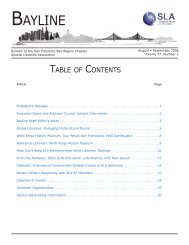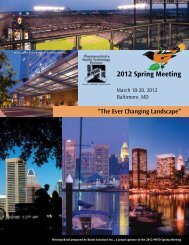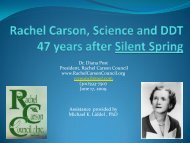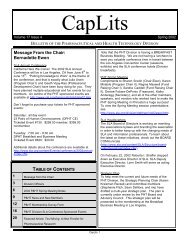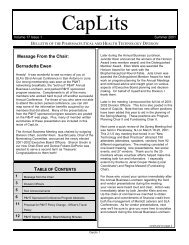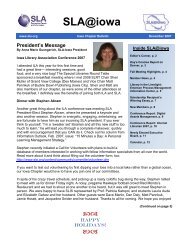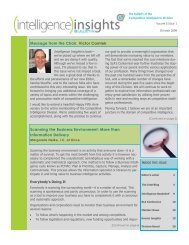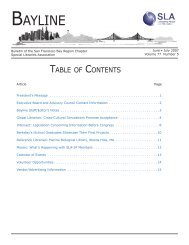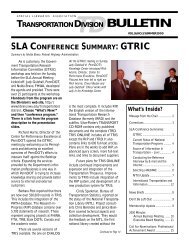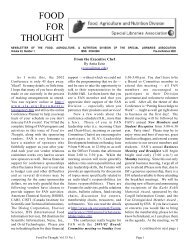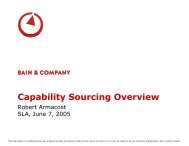Education Libraries - Special Libraries Association
Education Libraries - Special Libraries Association
Education Libraries - Special Libraries Association
Create successful ePaper yourself
Turn your PDF publications into a flip-book with our unique Google optimized e-Paper software.
The middle chapters outline the practical and<br />
technological elements in preparing for the event, such<br />
as choosing software and hardware, physically setting up<br />
hardware, and promoting events. While the author does<br />
tell you exactly what you need to know and do, I found<br />
the organization of the chapters a little confusing and<br />
disappointing. The chapters do not provide a step by step<br />
guide but combine practical information from later<br />
chapters while talking about higher level concepts.<br />
What the author has done particularly well is create<br />
charts of the different types of games, and rate them for<br />
tournament play by software ratings (E, T, M, much like<br />
ratings for movies) and by different subgenres. The<br />
charts make game selection much easier if you are<br />
unfamiliar with the genres.<br />
The chapter on “Setting It Up or More about Cables<br />
Than You Ever Wanted to Know” is particularly useful<br />
and perfect for someone who has never before used a<br />
console or built a lab. After reading this chapter a<br />
complete novice could mount a tournament without<br />
pulling all their hair out or tripping on cables.<br />
I must confess that I also identify as a geek and a gamer.<br />
Even so, there were some terms that the author uses in<br />
the book that I didn’t know or understand. While the<br />
book offers a fairly complete index, it would have been<br />
helpful to also have a glossary to refer to for unfamiliar<br />
vocabulary.<br />
Overall the book is a well written primer on the logistics<br />
of setting up gaming in your library. While it is not a<br />
step by step how to and it lacks empirical data to support<br />
why gaming helps libraries, this book is as enjoyable as<br />
it is instructive. This is a must read for anyone<br />
considering gaming in their library and a should read for<br />
teen and youth librarians.<br />
Elizabeth J. Bollinger is systems librarian at the Digital<br />
& Multimedia Center/Vincent Voice Library, Michigan<br />
State University. Email: bolling7@mail.lib.msu.edu<br />
Assess for Success,<br />
2 nd ed.—Reviewed<br />
by Celeste Moore<br />
Sitlington, Patricia<br />
L., Neubert, Debra<br />
A, Begun, Wynne<br />
H., Lombard,<br />
Richard C. ,<br />
Leconte, Pamela J.<br />
Assess for Success,<br />
2 nd ed. Thousand<br />
Oaks, CA: Corwin<br />
Press, 2007. ISBN<br />
978-1-4129-5281-1.<br />
$31.95.<br />
Assess for Success, 2 nd Edition, is an important resource<br />
for practitioners and other members of IEP teams. The<br />
book will serve as a guide to help plan and assess the<br />
transition process of students entering into adult life as it<br />
cover this important topic in great depth and clarity. The<br />
authors describe members of the IEP team as the target<br />
audience because “they assist a student of any disability<br />
and functioning level in defining his or her vision of the<br />
future and in reaching this vision.” This updated<br />
comprehensive and well organized text will assist<br />
students, families, and educators, and will make a lasting<br />
impact on the field.<br />
This joint publication is clearly thought out and<br />
designed. Each of the five authors is an expert in the<br />
field of special education and contributes both academic<br />
insights as well as professional, practical and research<br />
experience. The book begins by explaining the need for<br />
transition assessment, as well as the legislation relating<br />
to and the national standards impacting transition<br />
assessment. The authors also include examples of<br />
students dealing with transition and a variety of case<br />
studies for the development of chapter topics.<br />
The book has been organized into seven chapters<br />
containing an overview of transition assessment, career<br />
development, the role of self-determination, outcomes<br />
for IEP planning, roles of key players, methods of<br />
gathering information, and matching students to<br />
environments. Many chapters provide references and<br />
additional resources including both print and electronic.<br />
There are also helpful aids such as worksheets, and<br />
tables. There are also five appendixes and an index at the<br />
end of the book. The appendixes are also a useful<br />
<strong>Education</strong> <strong>Libraries</strong>, Volume 31, No. 2, Winter 2008 60



